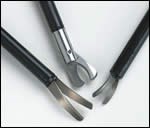Grinder Helps Medical Developer Transition To Manufacturing
Surgical Innovations (Si) is a pioneer in the development of equipment for endoscopic surgery. The Leeds, England company was established in 1992 by a surgeon and an instrument maker to develop an articulating instrument that could be inserted through a small hole and actuated into a predefined shape to move organs during laparoscopic surgery. Today Si designs, manufactures and supplies a range of products for minimally invasive procedures and autologous blood transfusion.
Surgical Innovations (Si) is a pioneer in the development of equipment for endoscopic surgery. The Leeds, England company was established in 1992 by a surgeon and an instrument maker to develop an articulating instrument that could be inserted through a small hole and actuated into a predefined shape to move organs during laparoscopic surgery. Today Si designs, manufactures and supplies a range of products for minimally invasive procedures and autologous blood transfusion.
Minimally invasive surgery (MIS) is the process of gaining surgical access to the body through small holes, or carrying out an operation without having to make a large incision. Minimal is the operative word here because trauma is reduced, thus facilitating quick recovery, minimizing scarring and reducing costs.
The company formerly designed but did not manufacture its products. In fact, it once outsourced all of its processes. Heavily relying on subcontracting meant that Si exercised little control over grinding quality. This lack of control and noticeably poor quality of grinding caused the company to evaluate ways to bring processes in-house. Ultimately, the company chose to make a foray into CNC technology, more specifically into creep-feed grinding. This move allowed the company to transition from developer to manufacturer while enhancing the quality of its components.
The purchase of a Dominator surface profile and creep-feed grinder from Jones & Shipman Inc. (Leicester, England) enabled the company to break into the manufacturing frontier and consequently broaden its customer base. Since then, Si has invested in sliding-headstock lathes and now produces all components in-house.
The machine features 3D contour grinding capabilities, a GE Fanuc control and the manufacturer’s own Windows-based software suite. Users can produce two-, three- or multi-facet cutting edges. Two fixtures retain removable cassettes, which can accommodate needles with diameters ranging from 0.001 inch to 0.18 inch (31 to 7 gauge) and lengths from 1 inch to 16 inches. In addition, each fixture can hold and grind virtually any programmed size of needle.
The first product in a new line of keyhole surgery devices was the “Logic” scissors device. This single-use device was launched during a delegation visit to Si as part of the sixth Society of Manufacturing Engineers (SME) Technology Conference, which was held in the United Kingdom. The company was able to grind components in this production line on its Dominator.
Manufacture begins with a stamped, punched and slotted stainless steel blank, measuring approximately 1.18 inch by 0.15 inches by 0.04 inch. For the first of two grinding operations, 24 blanks are loaded in a horizontal plane into a fixture to enable the hinge area section to be ground flat. A further operation using a second fixture loads 24 blades at an angle to grind the cutting edge on the blade. Both cycles require 2 minutes each to perform, thus producing a finished ground blade every 10 seconds. After bending to shape, the blades are assembled with a shaft, locknut and actuating mechanism to form the single-use device.
“To produce the scissors, we can load up the creep-feed grinder and then grind the blade edges in one pass,” explains Mr. Moran. “We also grind other components requiring full CNC control of the grinding head.”
Mr. Moran cites the creep-feed capability as an integral part of producing the single-use scissors in a cost-effective manner. Along with this capacity has come better control over costs and leadtimes.
Si has found that the new grinder has also been useful in machining other product lines, including cutting tubes for keyhole surgery. This type of surgery involves the use of laparoscopic attachments for the manipulation and repair of internal organs as well as the devices that enable these attachments to reach inside the body. For instance, in abdominal keyhole surgery, a hole is made in the abdominal wall to act as a working channel.
One such device is a keyhole surgery cutting tool also ground on the Dominator. These tubes, currently manufactured by Si, range in diameter from 0.20 inches to 0.50 inches; they are produced in a variety of lengths to accommodate various medical procedures. Using custom fixturing, designed and produced by Jones & Shipman, tubes in multiples of seven are held in a removable clamp and finish ground in two operations.
“We grind a tube, cut it off at an angle and end up with an elliptical shape,” says Mr. Moran. “Next, we take the ellipse and hollow grind it; turn the tube over; and put the sharp point on the outside of the tube. A plunger/spring loaded mechanism is located inside the tube.”
According to the company, these particular tubes have sold well—to the tune of thousands. Although Si says it could have found other ways to machine the scissors, the creep-feed feature was imperative in producing the other components.
“Without a doubt, we would not be able to adhere to such a high level of quality or attract and maintain the broadened customer base today had it not been for the creep-feed grinder,” concludes Mr. Moran.
Read Next
Rego-Fix’s Center for Machining Excellence Promotes Collaboration
The new space includes a showroom, office spaces and an auditorium that will enhance its work with its technical partners.
Read MoreRegistration Now Open for the Precision Machining Technology Show (PMTS) 2025
The precision machining industry’s premier event returns to Cleveland, OH, April 1-3.
Read More5 Rules of Thumb for Buying CNC Machine Tools
Use these tips to carefully plan your machine tool purchases and to avoid regretting your decision later.
Read More























